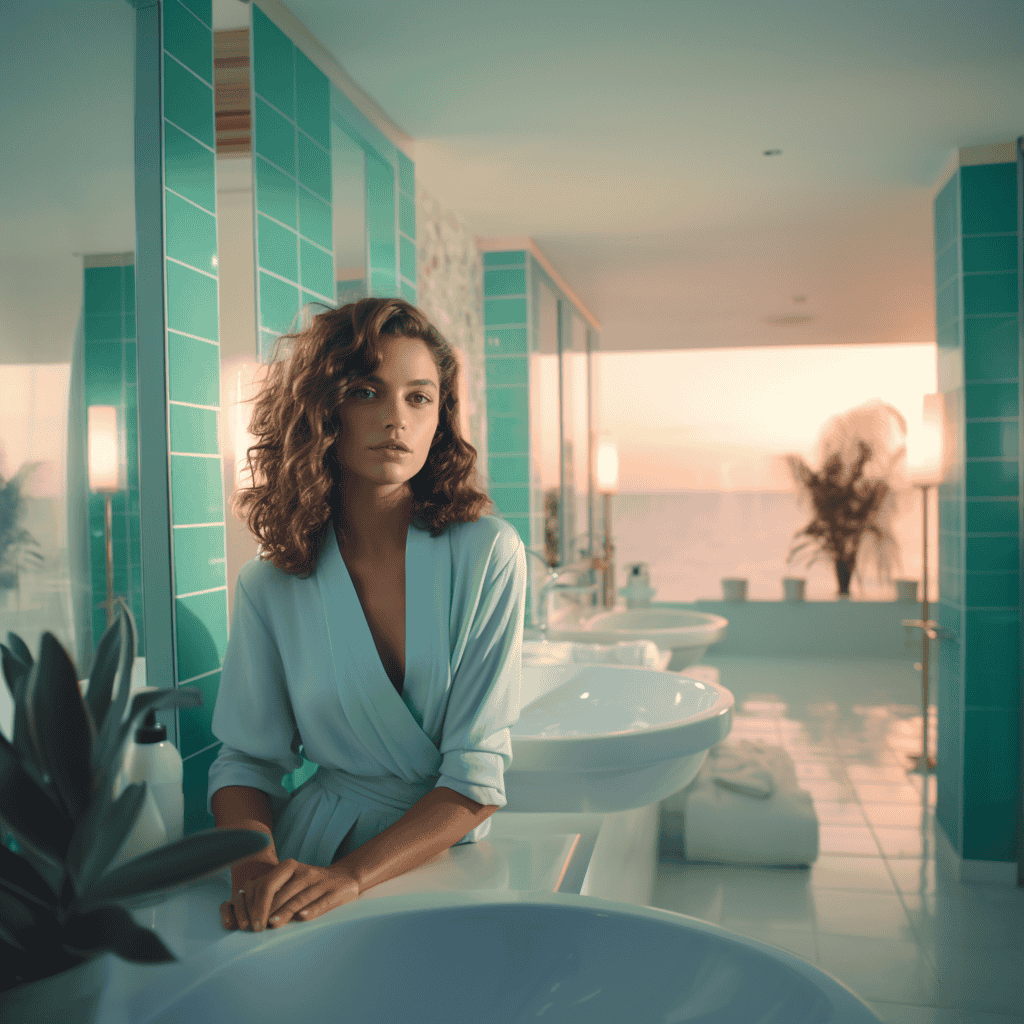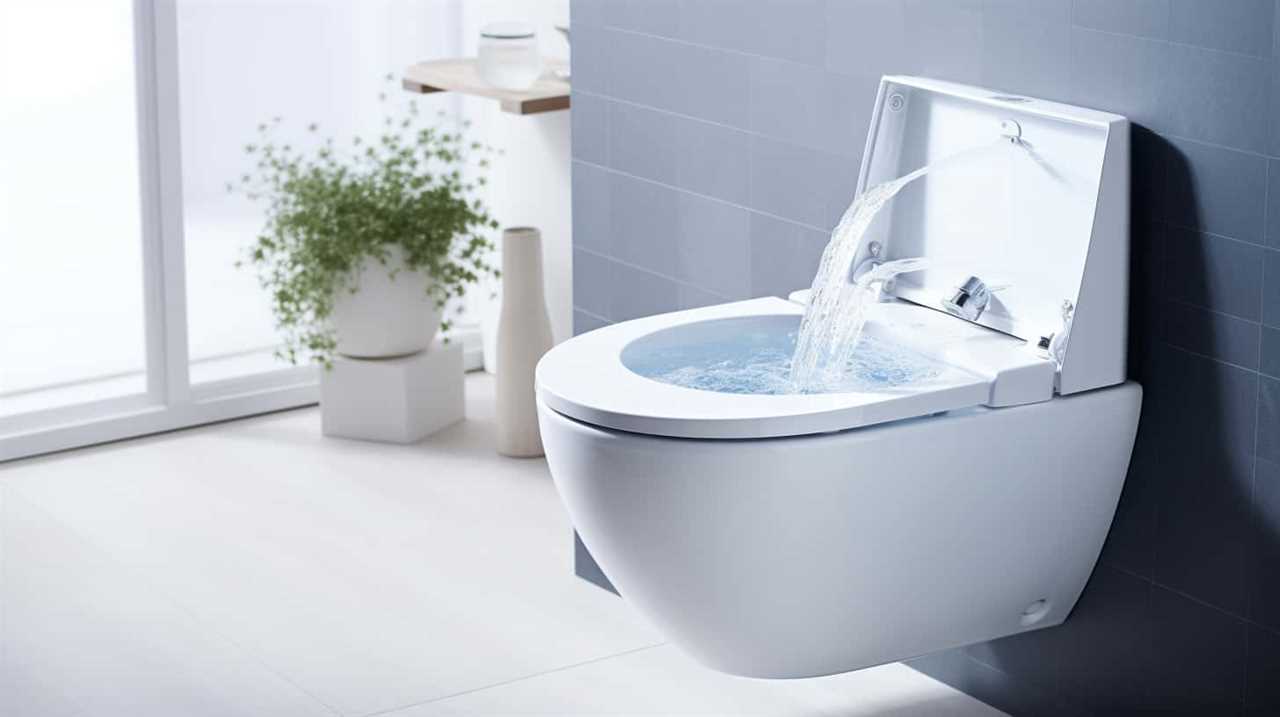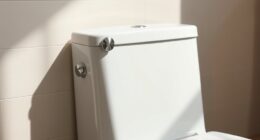Skirted toilets have a sleek, seamless exterior that looks modern and is easier to keep clean since there are fewer crevices for dirt buildup. Exposed trapway toilets show visible piping, giving a more traditional or industrial style but can trap grime, requiring more maintenance. If a clean, minimalist look appeals to you, skirted is your better option; for a classic vibe, exposed trapway works well. Want to know which style suits your bathroom best? Keep exploring.
Key Takeaways
- Skirted toilets have a sleek, seamless exterior, enhancing modern bathroom aesthetics.
- Exposed trapway toilets display visible piping, contributing to a traditional or industrial look.
- Skirted designs are easier to clean due to fewer crevices and smooth surfaces.
- Exposed trapway models may trap grime, requiring more effort to maintain cleanliness.
- Both styles maintain their appearance longer with proper bathroom fixture maintenance.

When choosing a new toilet, one of the key decisions is whether to go with a skirted or exposed trapway design. This choice influences not only the look of your bathroom but also how easy it is to install and maintain. Skirted toilets feature a smooth, seamless exterior that conceals the trapway, creating a sleek appearance. Exposed trapway models showcase the internal piping, which can add a more traditional or industrial aesthetic. Your decision should take into account available installation options and water efficiency, as these factors impact both convenience and environmental footprint.
Skirted toilets typically offer more flexible installation options. Because they have a concealed trapway, they can often be installed closer to the wall, saving space and providing a streamlined look. This design approach makes it easier to install in tight bathrooms or when replacing an older unit, as the hidden trapway reduces the need for precise alignment. Additionally, the smooth surface of a skirted toilet makes cleaning simpler. Without exposed crevices or piping, there’s less opportunity for grime to build up, which means you spend less time scrubbing and more time enjoying your bathroom.
Skirted toilets offer easier installation and simpler cleaning for a sleek, space-saving bathroom look.
Water efficiency is another critical factor to consider. Many modern skirted toilets are equipped with dual-flush systems or low-flow technology, helping you conserve water without sacrificing performance. These models often meet or exceed current efficiency standards, making them an eco-friendly choice. Exposed trapway toilets can also incorporate water-saving features, but they tend to be more common among traditional designs. If water conservation is a priority, you should compare specific models to ensure they meet your efficiency goals.
Aesthetically, skirted toilets tend to look cleaner and more modern, appealing to those who favor a minimalist style. Their smooth surface is less prone to trapping dirt and debris, making them a popular choice for contemporary bathrooms. In contrast, exposed trapway toilets can lend a more classic or industrial vibe, which might suit traditional or rustic bathroom designs. However, they can be more challenging to clean due to the exposed piping and crevices. Proper maintenance of the bathroom fixtures can help keep both styles looking their best over time.
Frequently Asked Questions
Which Type Is More Environmentally Friendly?
When considering which toilet is more environmentally friendly, focus on water conservation and eco-friendly materials. Both skirted and exposed trapway toilets can be efficient, but some models use less water per flush, reducing your environmental impact. Look for toilets with low-flow technology and made from sustainable materials. Your choice can help conserve water and minimize waste, making your bathroom more eco-friendly regardless of the trapway style.
Are Skirted Toilets Easier to Install Than Exposed Trapway Models?
You’ll find that skirted toilets often offer easier installation since their sleek design hides bolts and connections, reducing visual clutter. This can simplify setup, especially if you’re replacing an older model. Additionally, maintenance ease is improved because the smooth, skirted surface is easier to clean and less prone to grime buildup. Overall, skirted toilets tend to be more straightforward to install and maintain compared to exposed trapway models.
Do Skirted Toilets Cost More to Repair?
Think of repair costs like fixing a car—some parts are easier to access than others. Skirted toilets often have higher repair costs because their concealed trapway makes maintenance less straightforward, requiring more time and skill. While they may look sleek, their maintenance ease is reduced, making repairs potentially more expensive. So, if you prioritize easier repairs, exposed trapway models might be more cost-effective in the long run.
How Do Trapway Designs Affect Flushing Power?
Trapway shape directly impacts flushing efficiency by influencing water flow and waste removal. A smoother, larger trapway allows for better water movement, reducing clogs and improving overall flushing power. Conversely, a narrow or complex trapway can hinder flow, decreasing efficiency. When choosing a toilet, consider how the trapway design affects flushing performance to make certain of reliable operation and fewer maintenance issues, making your bathroom experience smoother and more hygienic.
Are There Differences in Odor Control Between the Two Styles?
Like a well-guarded fortress, the design influences odor containment and airflow efficiency. Skirted toilets often provide better odor control because their streamlined shape minimizes hidden areas where odors can linger. Exposed trapway models might allow less airflow efficiency, potentially leading to more odors escaping. You’ll notice that the sealed design of skirted toilets helps keep your bathroom smelling fresh, reducing the spread of unwanted smells effectively.
Conclusion
Choosing between skirted and exposed trapway toilets is about more than looks—it’s about ease, cleanliness, and confidence. With skirted designs, you get sleek style and simple cleaning. With exposed trapways, you gain easier maintenance and traditional appeal. Both options serve your needs, both enhance your space, and both offer comfort and convenience. Ultimately, it’s about making a choice that fits your lifestyle, your style, and your home—because your bathroom deserves nothing less than the best.










